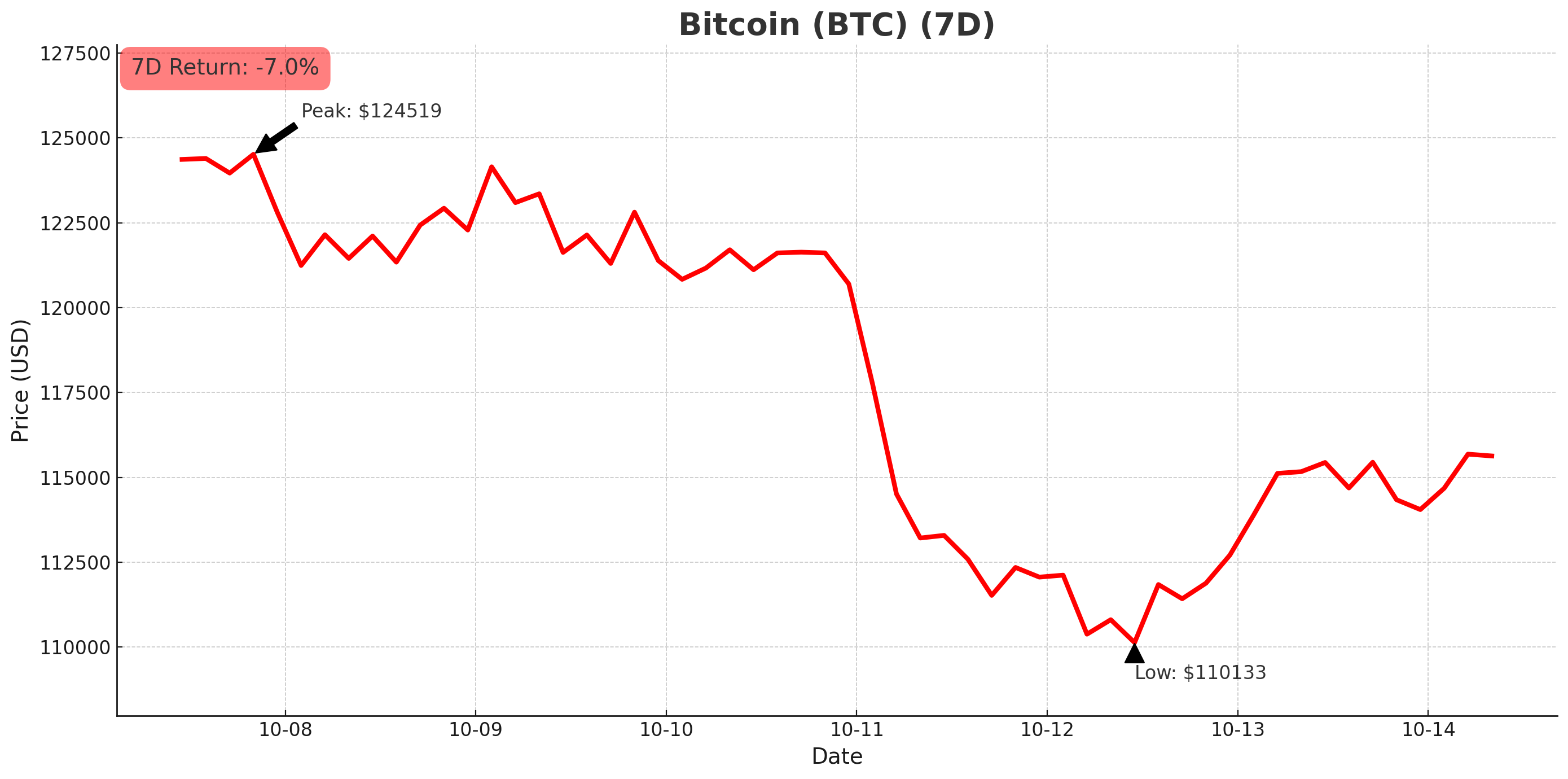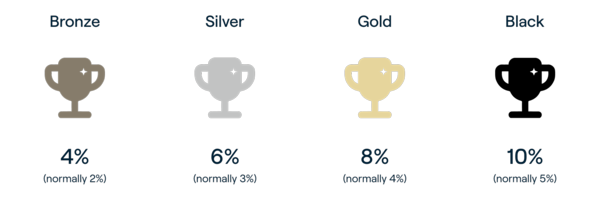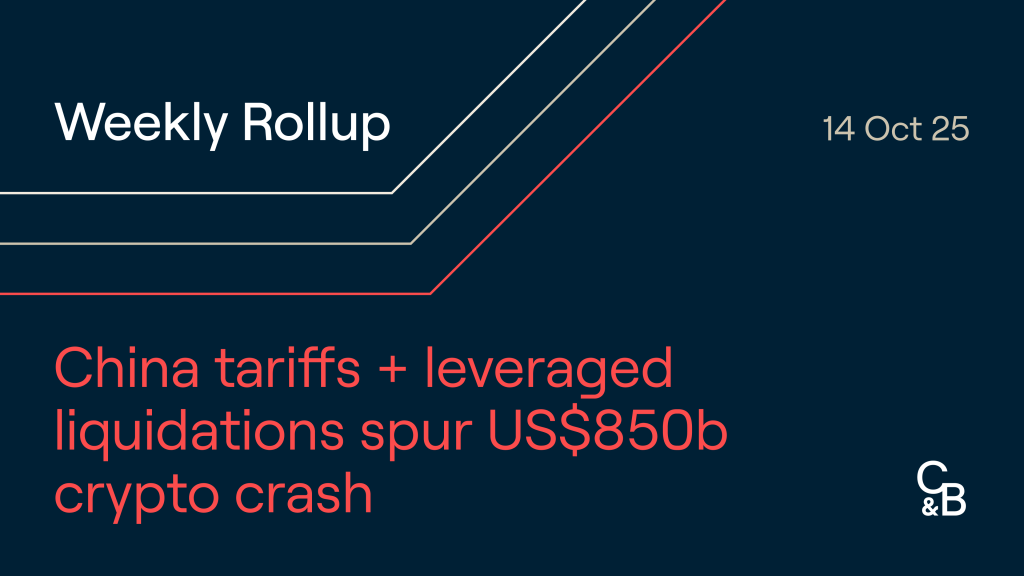Market highlights
- Before the October 10 crypto crash, bitcoin rallied to an all-time high of US$126,296.
- Over US$19 billion in positions were liquidated in this week’s crypto sell-off.
- Possible vulnerabilities in Binance’s Unified Account margin system exacerbated the sell-off.
- Several major banks are exploring a joint stablecoin project pegged to G7 currencies.
- Luxembourg’s sovereign wealth fund (FSIL) started buying BTC ETFs.
Markets Overview
Markets quietly continued to climb this week until Friday, October 10, when President Trump threatened to impose an additional 100% tariff on Chinese goods entering the U.S. The announcement came after Beijing said it was implementing new export controls on rare earths, which are essential for producing semiconductors and electric vehicles. The major indexes saw declines of between 2% and 3.5% in the worst session since the April 2 Liberation Day announcement. On Sunday, October 13, the President wound back the threat, stating that trade relations with China “will all be fine,” while Vice President JD Vance said the U.S. will negotiate with Beijing if officials are “willing to be reasonable”.
It was a quiet week for economic data as the U.S. government shutdown continues. At this stage, the next raft of employment data is tentatively scheduled for October 23. Looking to the week ahead, investors will presumably be watching for earnings results from major U.S. banks later in the week.
Weekly performance: S&P 500 -2.4%, Dow Jones -2.7%, Nasdaq -2.5%.
Looking ahead:
- U.S. Federal Reserve Chair Powell speaks – October 15
- U.S. core PPI – October 16
Crypto Market Sector Performance
Most sectors saw declines this week as the crypto market experienced a correction on October 10 amid tariff uncertainty and a flush of leveraged liquidations. It was the largest crypto sell-off in history, with over US$19 billion in crypto positions liquidated and the total crypto market cap declining by US$850 billion.
Some sources say that the liquidation event may have been a coordinated hit on Binance and one of its biggest market makers. It appears Binance’s Unified Account margin system may have been targeted. The system allows traders to use volatile assets as collateral instead of USDT or coin-margined positions. USDe, wBETH and BnSOl were the hardest hit, dropping to US$0.65, US$0.20 and US$0.13, respectively, while many altcoins fell to lower lows on Binance than on other exchanges. The losses on the platform range between US$500 million and US$1 billion.
Bitcoin (BTC)
- Opened the week at US$123,520, rallied to a new all-time high of US$126,296 on Monday, October 6 and then sold off to a low of US$107,000 on October 10 amid tariff uncertainty and a leveraged liquidation flush. Bitcoin’s price has since regained some strength, growing to around US$115,500 on Sunday, October 13, as President Trump softened his rhetoric around trade negotiations with China. (-8.1% 7D).
- BTC dominance grew this week from 59.3% to over 63% in Friday’s sell-off. BTC dominance has since settled back around 59%.
- Bitcoin investment products saw almost US$2.7 billion of inflows this week.
BlackRock’s iShares Bitcoin Trust (IBIT) became the asset manager’s most profitable exchange-traded fund (ETF) by annualised fee revenue this week. The ETF has US$97 billion worth of assets under management (AuM). IBIT is now generating more revenue than some of its products, such as the iShares Russell 1000 Growth ETF and iShares MSCI EAFE ETF, which have been trading for over 25 years. This demonstrates the record growth of bitcoin ETFs since their launch in January 2024.
Block Founder Jack Dorsey reignited calls for a de minimis tax exemption on everyday BTC transactions. This exemption was part of crypto tax reforms earlier this year, but it did not make it into President Trump’s reconciliation bill before it went to a vote. Senator Cynthia Lummis (R-WY) said she’s “Working on it”.
In bitcoin buying news:
- DDC Enterprise, a Hong Kong-based digital food company, secured US$124 million in funding to establish a bitcoin treasury. The company plans to build up a stockpile of 10,000 BTC.
- KindlyMD is raising US$250 million in convertible debt to crypto services provider, Antalpha. The capital will be used to continue building its BTC treasury, which currently holds 5,765 BTC.

Past performance is not a reliable indicator of future results.
Ethereum (ETH)
- Opened the week at US$4,515.40 and declined to a weekly low of US$3,510 amid Friday’s sell-off. Price has since recovered slightly to around US$4,250 (-9.5% 7D).
- Ethereum dominance hovered between 13% and 12.3% this week.
- Ethereum-focused funds saw inflows of US$338 million this week.
The Ethereum Foundation has launched a Privacy Cluster, a 47-member team led by Igor Barinov, to centralise the development of privacy features across the network. The cluster will collaborate with existing teams on initiatives such as private transactions, identity, and compliance, using tools like the upcoming Kohaku wallet SDK.

Past performance is not a reliable indicator of future results.
Altcoins
It’s no surprise that the altcoin season index remained below 75 this week. It currently sits at 49 as the market finds its bearings following the record sell-off.
DeFi-ing the odds
- Synthetix (SNX) gained 94.8%, rising over 80% on October 13, driven by hype surrounding the upcoming launch of its Perp DEX on the Ethereum mainnet. The network also announced a trading competition, which will award prizes to the top 100 traders, including a top prize of US$1 million.
TAO exciting
- Bittensor (TAO) grew by 28.7%, breaking out of long-term resistance to trade over US$400 per token. The gains are presumably driven by increased investor interest following Grayscale’s filing with the U.S. Securities and Exchange Commission (SEC) to launch its Bittensor Trust ($TAO). If Grayscale’s application is approved, the Trust will begin filing quarterly, annual and current reports, plus financial statements, like public companies.
DeFi declines
- Kava (KAVA) declined by 41.5%. The decentralised multi-chain lending network saw a steep decline of 48% in the end-of-week market correction, presumably due to bearish sentiment in DeFi. Despite being in bearish territory, some sources say its integration with Cosmos for cross-chain lending and its attractive staking rewards could see KAVA bounce back in the long term.
Crypto ETF News
Digital asset investment products saw inflows of almost US$3.2 billion this week, demonstrating resilience despite the October 10 sell-off. Total AuM declined by 7% to US$242 billion due to the correction. Also this week, ETF trading volumes hit record highs, growing to US$53 billion.
In altcoins, Solana and XRP saw inflows of US$93.3 million and US$61.6 million, respectively.
Bitwise and 21Shares submitted filings this week to bring staking to some of their products. The Bitwise Solana Staking ETF will allow staking, while the filing also introduced a 0.2% unitary management fee to cover operating costs. Similarly, 21Shares applied to add staking to its 21Shares Ethereum ETF (TETH) and will waive its 0.21% sponsor fee for 12 months from October 9. Also this week, Grayscale introduced staking to its Ethereum Trust ETF (ETHE).

Other crypto news
- S&P Dow Jones Indices announced the launch of the Digital Markets 50, a new benchmark index tracking 15 cryptocurrencies and 35 publicly traded companies with significant digital asset exposure. The index aims to provide institutional investors with a comprehensive measure of the crypto ecosystem’s performance. Tokenisation firm Dinari will issue a token representing the index. The new index will debut in a few weeks.
- The U.S. SEC is set to formalise its recently announced “innovation exemption” under its Project Crypto initiative by year-end. The measure aims to provide crypto and fintech startups with a defined regulatory framework, offering exemptions and safe harbours to foster innovation while ensuring compliance with existing laws.
- Several major banks, including Bank of America, Citi, and Goldman Sachs, are exploring a joint stablecoin project pegged to G7 currencies. The initiative aims to blend blockchain efficiency with institutional trust, subject to compliance, risk standards, and potential collaboration with networks like Zelle and Clearing House. In other stablecoin news, North Dakota’s state bank and fintech firm Fiserv will launch Roughrider Coin, a dollar-backed stablecoin on Fiserv’s FIUSD platform. Banks and credit unions will be eligible to use the stablecoin following its anticipated 2026 launch.
- Luxembourg’s sovereign wealth fund (FSIL) has allocated 1% of its portfolio, worth approximately US$8 to US$9 million, to bitcoin ETFs. This makes it the first Eurozone state fund to invest in bitcoin via ETFs. The investment follows a July 2025 policy update, which said the fund would rebalance its portfolio to allocate up to 15% of its holdings to alternative assets, such as BTC, private equity and real estate.
- Industry groups in the UK have expressed tepid support following reports that the Bank of England may exempt crypto exchanges from proposed stablecoin holding caps of GBP£10 million for businesses and GBP£10,000 to GBP£20,000 for individuals. Critics argue the caps are impractical, enforcement is unworkable, and limits could stifle innovation.
- Intercontinental Exchange (ICE), the owner of the New York Stock Exchange (NYSE), is going to invest up to US$2 billion in the prediction market platform, Polymarket. The investment values the platform at US$9 billion, making it one of the largest institutional investments to date in DeFi. It will also establish ICE as the global distributor for Polymarket’s data to institutional investors, including sentiment indicators for events across financial markets, politics, sports and culture.
In Case You Missed It!

Caleb & Brown is doubling your referral rewards for new verified clients referred in October.
🏆 Bonus: The top referrer this month wins USDC $2,000!




